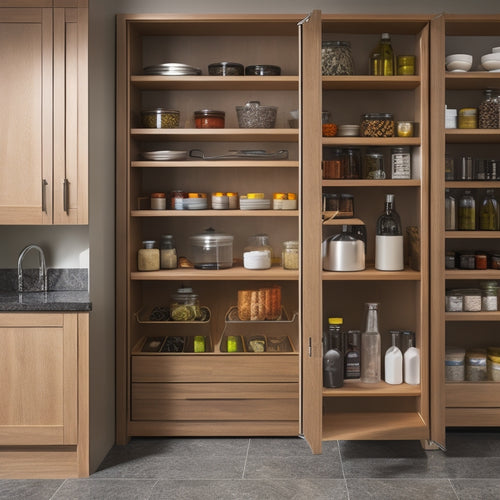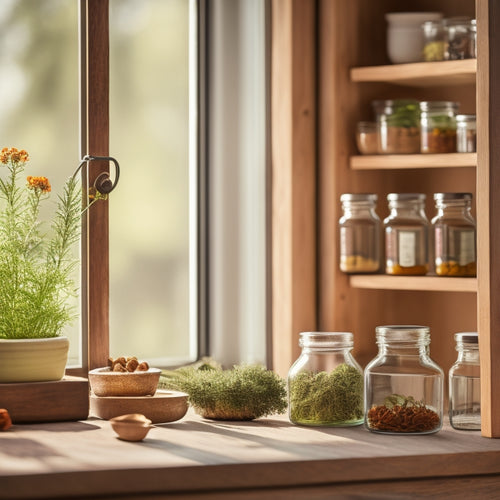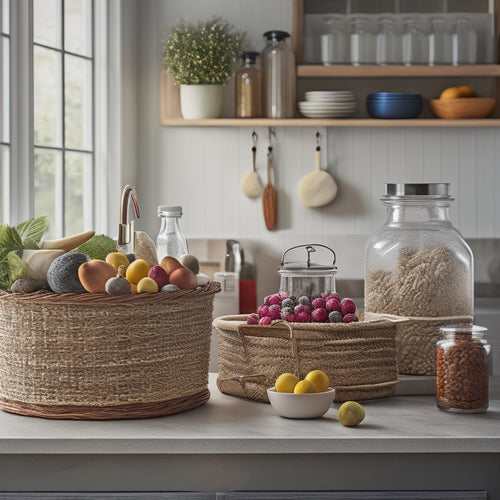
Gluten-Free Meal Prep: Storage Solutions and Tips
Share
You've optimized your gluten-free meal prep game, now it's time to focus on storage and organization. Choose airtight, durable containers made of glass, stainless steel, or sturdy plastic to prevent flavor absorption and maintain freshness. Implement a labeling system with date, meal name, and 'GF' indicator, and consider color coding for meal types. Prioritize pantry and refrigerator organization, and utilize vertical space with adjustable shelving. By following these storage solutions and tips, you'll be able to uphold the quality of your gluten-free meals and keep your kitchen organized. Now, take the next step and discover how to tailor your storage system to your meal prep needs.
Key Takeaways
• Choose airtight, non-porous containers made of glass, stainless steel, or sturdy plastic to prevent flavor absorption and cross-contamination.
• Implement a labeling system with date, meal name, and 'GF' indicator to ensure easy identification and organization of gluten-free meals.
• Utilize color coding for meal types and allocate shelves in the pantry and refrigerator for gluten-free staples to optimize storage space.
• Select containers of different sizes for various meal portions and use airtight, stackable containers for freshness and space optimization.
• Label and date containers to minimize waste, promote organization, and ensure accurate serving sizes for healthy, gluten-free meals.
Choosing the Right Containers
You'll need containers that are airtight, easy to clean, and durable enough to withstand multiple uses when preparing gluten-free meals in advance. Look for containers made from high-quality, BPA-free materials like glass, stainless steel, or sturdy plastic. These materials will guarantee your containers are non-porous and won't absorb flavors or odors.
Consider the size of your containers, too. You'll want a variety of sizes to accommodate different meal portions and ingredients. For example, small containers are perfect for storing spices, nuts, or seeds, while larger containers can hold entire meals or batches of cooked ingredients.
When it comes to sealing options, opt for containers with secure, leak-proof lids. You can choose from screw-top lids, snap-on lids, or even containers with vacuum-sealing capabilities.
Durability is also essential, so select containers that can withstand extreme temperatures, from freezer to oven. By choosing the right containers, you'll be able to store your gluten-free meals safely and efficiently, making meal prep a breeze.
Labeling and Organizing Systems
With your containers in place, it's time to implement a labeling and organizing system that helps you quickly identify the contents and their gluten-free status, making sure you can grab and go with confidence.
A labeling system can be as simple as using stickers or labels with the date, meal name, and 'GF' (gluten-free) indicator. You can also use color coding to differentiate between meal types, such as breakfast, lunch, or dinner. For instance, use green labels for breakfast meals and blue for lunch.
In addition to labeling, consider pantry organization systems to maximize storage space and keep your gluten-free ingredients within easy reach. You can use baskets, bins, or shelves to categorize and store ingredients like gluten-free flours, pasta, and snacks.
Gluten-Free Meal Prep Essentials
Beyond a reliable labeling and organizing system, having the right gluten-free meal prep essentials in your kitchen can make all the difference in efficiently preparing healthy, gluten-free meals. You'll want to stock up on cooking staples like gluten-free flours, oils, and spices to guarantee you have the foundation for a variety of gluten-free recipe ideas.
| Essential Item | Description |
|---|---|
| Gluten-free cookbooks | Provides inspiration and guidance for new recipes and meal prep hacks |
| Meal prep containers | Allows for easy storage and transportation of prepared meals |
| Instant Pot or pressure cooker | Enables quick and easy cooking of grains, proteins, and vegetables |
Additionally, consider investing in a good quality Instant Pot or pressure cooker, which can be a game-changer for cooking grains, proteins, and vegetables quickly and efficiently. Having these essentials on hand will help you stay on track with your meal prep goals and provide a sense of confidence in the kitchen. With these must-haves, you'll be well-equipped to experiment with new gluten-free recipe ideas and meal prep hacks, making healthy eating a breeze.
Storage for Fresh Ingredients
Five crucial storage solutions are essential for maintaining the freshness and quality of your gluten-free ingredients. You'll want to prioritize refrigerator organization, making sure that perishable items like fruits, vegetables, and dairy alternatives are stored in airtight containers to prevent moisture and contamination.
In your pantry, designate specific shelves for gluten-free staples like rice, quinoa, and gluten-free flours, and use baskets or bins to keep them organized and visible.
When it comes to freezer options, you'll want to invest in airtight containers or freezer bags that can withstand extreme temperatures without compromising the integrity of your ingredients. Label and date each container or bag, so you can easily identify what you have and how long it's been stored. This will help you avoid cross-contamination and guarantee that your gluten-free ingredients remain fresh and safe to consume.
Portion Control Container Tips
You'll need a system of portion control containers to accurately measure and store your gluten-free meals, making sure you're consuming the right amounts and reducing food waste. This is especially important when cooking for others, as it guarantees everyone gets the right serving size.
When selecting portion control containers, consider the following:
-
Choose a variety of container sizes: Having containers of different sizes allows you to store individual portions of various gluten-free meals, from small snacks to larger entrees.
-
Label and date containers: Clearly labeling and dating each container ensures you know exactly what's inside and how long it's been stored, making meal prep a breeze.
-
Use containers that are airtight and stackable: Airtight containers keep food fresh, while stackable containers maximize storage space in your fridge or freezer.
Keeping Food Fresh Longer
To maintain the freshness of your gluten-free meals for a longer period, implementing appropriate storage and refrigeration techniques is essential. You can extend the shelf life of your meals by using vacuum sealing, which eliminates air from the container, preventing bacterial growth. Additionally, organizing your pantry with a 'first-in, first-out' system guarantees that older meals are consumed before newer ones.
| Storage Method | Benefits |
|---|---|
| Vacuum Sealing | Prevents bacterial growth, keeps food fresh for a longer duration |
| Freezer Storage | Preserves nutrients, ideal for cooked meals |
| Pantry Organization | Reduces food waste, ensures meal rotation |
| Refrigeration | Slows down bacterial growth, ideal for short-term storage |
When it comes to meal rotation, make certain to label and date your meals, so you can easily identify which ones need to be consumed first. By implementing these storage solutions, you'll be able to keep your gluten-free meals fresh for a longer period, reducing food waste and saving time. Remember, proper storage is essential to maintaining the quality and safety of your meals.
Preventing Cross Contamination
When preparing gluten-free meals, it's important that you take steps to prevent cross contamination with gluten-containing ingredients, as even trace amounts can cause adverse reactions. This requires a combination of allergen awareness, safe handling, and proper cleaning procedures.
Here are some essential tips to prevent cross contamination:
-
Designate gluten-free zones: Assign specific areas for gluten-free food preparation and storage to minimize the risk of cross contamination.
-
Use separate utensils and equipment: Make sure that all utensils, cutting boards, and equipment used for gluten-free meal prep are separate from those used for gluten-containing ingredients.
-
Clean and sanitize frequently: Regularly clean and sanitize all surfaces, utensils, and equipment to prevent the spread of gluten.
Space-Saving Storage Solutions
With your gluten-free meal prep space organized and cross contamination under control, now it's time to maximize your storage space with clever solutions that keep your ingredients and prepared meals easily accessible.
You'll want to make the most of your available space, ensuring that everything has a designated spot and can be quickly retrieved when needed.
One effective way to do this is by using vacuum sealing. By removing air from containers, you'll reduce storage space and prevent freezer burn.
You can also use stackable bins to store dry goods like gluten-free flours, grains, and snacks. Label each bin so you can easily identify what's inside. This will help you maintain a tidy and organized space, making meal prep a breeze.
Additionally, consider using airtight containers with built-in handles for easy transport and storage. These containers are perfect for storing prepared meals, such as soups, salads, or cooked proteins.
Meal Prep for Busy Lives
You're likely no stranger to chaotic mornings, hectic lunch breaks, and exhausting evenings, but gluten-free meal prep can be a game-changer for busy lives. By dedicating a few hours on the weekend to prep healthy, gluten-free meals, you can save time and energy during the week. This allows you to focus on what matters most - serving others and taking care of yourself.
Here are three ways meal prep can benefit your busy life:
-
Time-saving recipes: Prep a large batch of rice, quinoa, or roasted vegetables on the weekend, and use them throughout the week in different meals.
-
Healthy snacks: Prepare healthy snacks like energy balls, trail mix, or cut veggies with hummus to curb cravings and fuel your body.
-
Reduced stress: Knowing that you have a stash of healthy meals ready to go can reduce stress and anxiety, allowing you to tackle your busy schedule with confidence.
Customizing Your Storage System
Designing a tailored storage system for your gluten-free meal prep is crucial to maintaining organization, saving space, and guaranteeing easy access to your prepped meals throughout the week. By customizing your storage, you can optimize your pantry organization and meal planning, making it simpler to plan and prepare healthy, gluten-free meals.
Here are some tips to get you started:
| Storage Solution | Benefits |
|---|---|
| Adjustable shelving | Maximizes vertical space, accommodates different container sizes |
| Clear storage bins | Visibility, easy identification, and access to ingredients |
| Label maker | Identifies contents, promotes food rotation, and reduces waste |
When it comes to freezer storage, consider the 'first in, first out' rule to guarantee food rotation and minimize waste. Label and date each container or bag, and store them in a way that makes sense for your meal planning and prep routine. By implementing these storage solutions, you'll be able to efficiently store and access your gluten-free meal prep, making healthy eating easier and more convenient.
Frequently Asked Questions
Can I Reuse Plastic Containers That Previously Held Gluten-Containing Foods?
'Don't count your chickens before they hatch' - when reusing plastic containers that previously held gluten-containing foods, you're taking a risk. Cross contamination risks are high, so it's essential to thoroughly sterilize those containers before using them for gluten-free meal prep.
How Do I Prevent Freezer Burn on Gluten-Free Meals?
When freezing gluten-free meals, you'll prevent freezer burn by using airtight, vacuum-sealed containers or freezer bags, ensuring ideal freshness for your batch-cooked masterpieces, so they remain safe and delicious for serving.
Are Glass Containers More Expensive Than Plastic Containers?
You'll find that glass containers are often more expensive upfront, but they're more durable and offer a lower environmental impact in the long run, making them a worthwhile investment for your storage needs.
Can I Store Cooked and Uncooked Gluten-Free Food Together?
You're worried about sacrificing convenience for safety, but don't - you can store cooked and uncooked gluten-free food together if you follow storing guidelines to prevent cross contamination, using separate storage solutions for each meal prep.
Do I Need to Wash Containers After Every Single Use?
You should wash containers after every use to maintain proper sanitation and extend their longevity; even if you're storing gluten-free food, residue buildup can harbor bacteria, so soap and water are a must after each use.
Related Posts
-

Space-Saving Lazy Susan Cabinet Solutions
Space-saving Lazy Susan cabinet solutions can change those awkward corner spaces into organized storage wonders. You'...
-

Spice Rack With Integrated Herb Garden
A spice rack with an integrated herb garden alters your kitchen into a culinary haven. You'll have fresh herbs at you...
-

Countertop Storage Ideas for Busy Homeowners
As a busy homeowner, optimizing your kitchen countertop is essential for efficiency and style. Consider using vertica...


